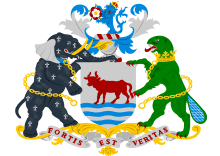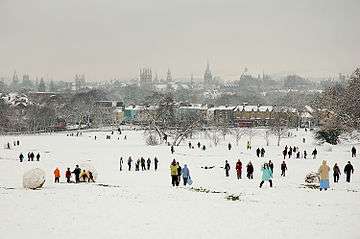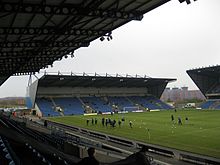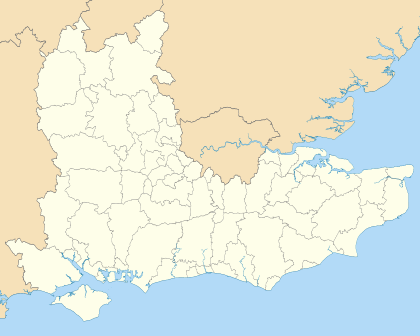Oxford
Oxford (/ˈɒksfərd/)[3][4] is a university city in Oxfordshire, England, with a population of 154,600.[1] It is 56 miles (90 km) northwest of London, 64 miles (103 km) from Birmingham and 24 miles (39 km) from Reading by road.
Oxford | |
|---|---|
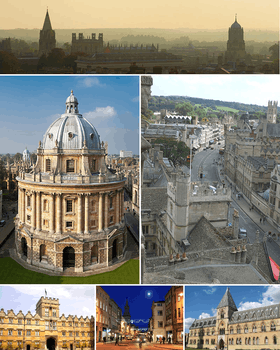 From top left to bottom right: Oxford skyline panorama from St Mary's Church; Radcliffe Camera; High Street from above looking east; University College, main quadrangle; High Street by night; Natural History Museum and Pitt Rivers Museum | |
| Nickname(s): "the City of Dreaming Spires" | |
| Motto(s): "Fortis est veritas" "The truth is strong" | |
 Shown within Oxfordshire | |
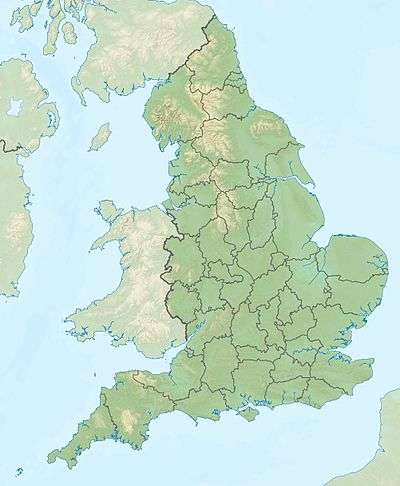 Oxford Location within England 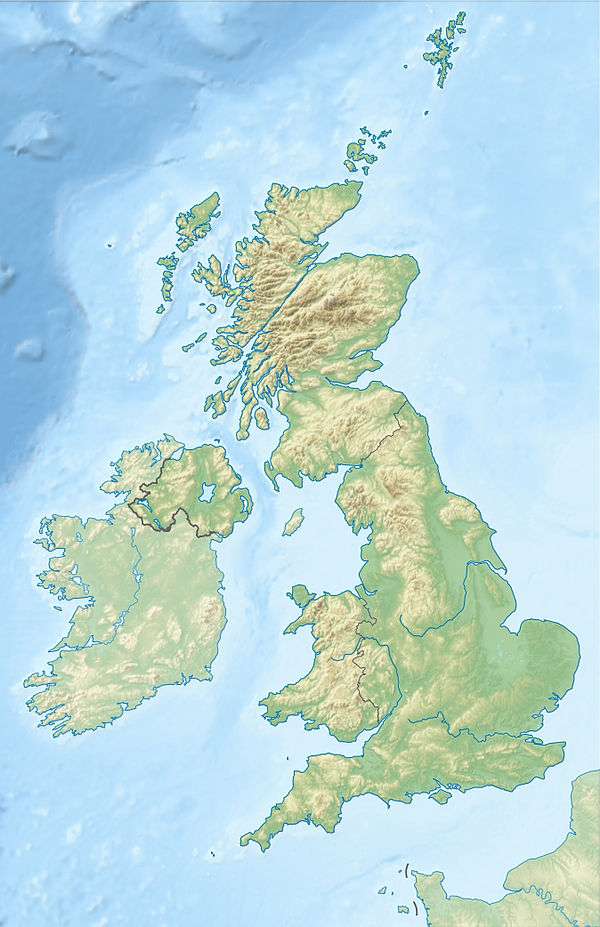 Oxford Location within the United Kingdom  Oxford Location within Europe | |
| Coordinates: 51°45′7″N 1°15′28″W | |
| Sovereign state | United Kingdom |
| Country | England |
| Region | South East England |
| Ceremonial county | Oxfordshire |
| Admin HQ | Oxford City Centre |
| Founded | 8th century |
| City status | 1542 |
| Government | |
| • Type | City |
| • Governing body | Oxford City Council |
| • Sheriff of Oxford | Craig Simmons |
| • Executive | Labour |
| • MPs | Anneliese Dodds (Labour) Layla Moran (Liberal Democrat) |
| Area | |
| • City and non-metropolitan district | 17.60 sq mi (45.59 km2) |
| Population (2017) | |
| • City and non-metropolitan district | 154,600[1] |
| • Density | 8,500/sq mi (3,270/km2) |
| • Metro | 244,000 |
| • Ethnicity (2011)[2] | 63.6% White British 1.6% White Irish 12.5% Other White 12.5% British Asian 4.0% Mixed Race 4.6% Black 1.4% Other |
| Demonym(s) | Oxonian |
| Time zone | UTC0 (GMT) |
| • Summer (DST) | UTC+1 (BST) |
| Postcode | |
| Area code(s) | 01865 |
| ISO 3166-2 | GB-OXF |
| ONS code | 38UC (ONS) E07000178 (GSS) |
| OS grid reference | SP513061 |
| Website | www.oxford.gov.uk |
The city is home to the University of Oxford, the oldest university in the English-speaking world,[5] and has buildings in every style of English architecture from late Anglo-Saxon. Oxford's industries include motor manufacturing, education, publishing, information technology and science.
History
Medieval
Oxford was first settled by the Anglo-Saxons and was initially known as Oxenaforda, meaning "ford of the oxen",[6] as referenced in Florence of Worcester's Chronicon ex chronicis.[7] A river crossing for oxen began around AD 900.
In the 10th century, Oxford became an important military frontier town between the kingdoms of Mercia and Wessex and was raided by Danes. In 1002, many Danes were killed in Oxford during the St. Brice's Day massacre ordered by Æthelred the Unready.[8] The skeletons of more than thirty suspected victims were unearthed in 2008 during the course of building work at St John's College.[9] The ‘massacre’ was a contributing factor to King Sweyn I of Denmark’s invasion of England in 1003 and the sacking of Oxford by the Danes in 1004.[10]
Oxford was heavily damaged during the Norman Invasion of 1066. Following the conquest, the town was assigned to a governor, Robert D'Oyly, who ordered the construction of Oxford Castle to confirm Norman authority over the area. The castle has never been used for military purposes and its remains survive to this day. D'Oyly set up a monastic community in the castle consisting of a chapel and living quarters for monks (St George in the Castle). The community never grew large but it earned its place in history as one of Britain's oldest places of formal education. It was there that in 1139 Geoffrey of Monmouth wrote his History of the Kings of Britain, a compilation of Arthurian legends.[11] Additionally, there is evidence of Jews living in the city as early as 1141, and during the 12th century the Jewish community is estimated to have numbered about 80–100.[12] The city was besieged during The Anarchy in 1142.[13]
In 1191, a city charter stated in Latin,[14]
"Be it known to all those present and future that we, the citizens of Oxford of the Commune of the City and of the Merchant Guild have given, and by this, our present charter, confirm the donation of the island of Midney with all those things pertaining to it, to the Church of St. Mary at Oseney and to the canons serving God in that place.
Since, every year, at Michaelmas the said canons render half a mark of silver for their tenure at the time when we have ordered it as witnesses the legal deed of our ancestors which they made concerning the gift of this same island; and besides, because we have undertaken on our own part and on behalf of our heirs to guarantee the aforesaid island to the same canons wheresoever and against all men; they themselves, by this guarantee, will pay to us and our heirs each year at Easter another half mark which we have demanded; and we and our heirs faithfully will guarantee the aforesaid tenement to them for the service of the aforesaid mark annually for all matters and all services.
We have made this concession and confirmation in the Common council of the City and we have confirmed it with our common seal. These are those who have made this concession and confirmation.
(There follows a list of witnesses, ending with the phrase, "... and all the Commune of the City of Oxford.")
Oxford's prestige was enhanced by its charter granted by King Henry II, granting its citizens the same privileges and exemptions as those enjoyed by the capital of the kingdom; and various important religious houses were founded in or near the city. Oxford's status as a liberty obtained from this period until the 19th century.[15] A grandson of King John established Rewley Abbey for the Cistercian Order; and friars of various orders (Dominicans, Franciscans, Carmelites, Augustinians and Trinitarians) all had houses of varying importance at Oxford. Parliaments were often held in the city during the 13th century. The Provisions of Oxford were instigated by a group of barons led by Simon de Montfort; these documents are often regarded as England's first written constitution.
Richard I of England (reigned 6 July 1189 – 6 April 1199) and John, King of England (reigned 6 April 1199 – 19 October 1216) the sons of Henry II of England, were both born at Beaumont Palace in Oxford, on 8 September 1157 and 24 December 1166 respectively. A plaque in Beaumont Street commemorates these events.[16]
University of Oxford
The University of Oxford is first mentioned in 12th-century records. Of the hundreds of aularian houses that sprang up across the city, only St Edmund Hall (c. 1225) remains. What put an end to the halls was the emergence of colleges. Oxford's earliest colleges were University College (1249), Balliol (1263) and Merton (1264). These colleges were established at a time when Europeans were starting to translate the writings of Greek philosophers. These writings challenged European ideology, inspiring scientific discoveries and advancements in the arts, as society began to see itself in a new way. These colleges at Oxford were supported by the Church in the hope of reconciling Greek philosophy and Christian theology. The relationship between "town and gown" has often been uneasy – as many as 93 students and townspeople were killed in the St Scholastica Day Riot of 1355.
The sweating sickness epidemic in 1517 was particularly devastating to Oxford and Cambridge where it killed half of both cities' populations, including many students and dons.[17]
Christ Church Cathedral, Oxford is unique in combining a college chapel and a cathedral in one foundation. Originally the Priory Church of St Frideswide, the building was extended and incorporated into the structure of the Cardinal's College shortly before its refounding as Christ Church in 1546, since when it has functioned as the cathedral of the Diocese of Oxford.
The Oxford Martyrs were tried for heresy in 1555 and subsequently burnt at the stake, on what is now Broad Street, for their religious beliefs and teachings. The three martyrs were the bishops Hugh Latimer and Nicholas Ridley, and the archbishop Thomas Cranmer.[18] The Martyrs' Memorial stands nearby, round the corner to the north on St. Giles.
Early modern
English Civil War
During the English Civil War, Oxford housed the court of Charles I in 1642, after the king was expelled from London. The town yielded to Parliamentarian forces under General Fairfax in the Siege of Oxford of 1646. It later housed the court of Charles II during the Great Plague of London in 1665–66. Although reluctant to do so, he was forced to evacuate when the plague got too close. The city suffered two serious fires in 1644 and 1671.[19]
Late modern
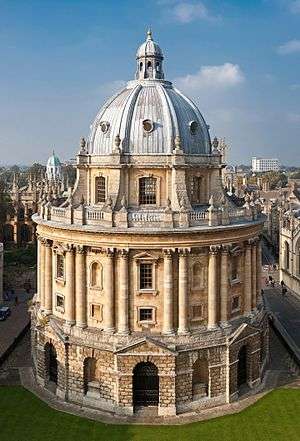
In 1790, the Oxford Canal connected the city with Coventry. The Duke's Cut was completed by the Duke of Marlborough in 1789 to link the new canal with the River Thames; and, in 1796, the Oxford Canal company built its own link to the Thames, at Isis Lock. In 1844, the Great Western Railway linked Oxford with London via Didcot and Reading,[20][21] and other rail routes soon followed.
In the 19th century, the controversy surrounding the Oxford Movement in the Anglican Church drew attention to the city as a focus of theological thought.
A permanent military presence was established in the city with the completion of Cowley Barracks in 1876.[22]
Local government in Oxford was reformed by the Municipal Corporations Act 1835, and the boundaries of the borough were extended to include a small area east of the River Cherwell. The boundaries were further extended in 1889 to add the areas of Grandpont and New Hinksey, south of the Thames, which were transferred from Berkshire to Oxfordshire. At the same time Summertown and the western part of Cowley were also added to the borough. In 1890 Oxford became a county borough.[15]
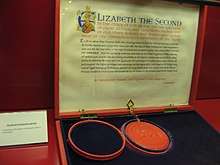
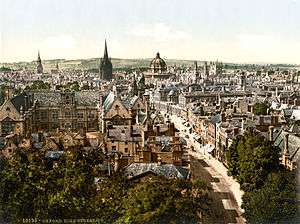
Oxford Town Hall was built by Henry T. Hare; the foundation stone was laid on 6 July 1893 and opened by the future King Edward VII on 12 May 1897. The site has been the seat of local government since the Guild Hall of 1292 and though Oxford is a city and a Lord Mayoralty, the building is still called by its traditional name of "Town Hall".
20th and 21st centuries
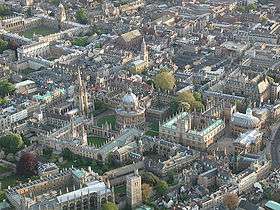
During the First World War, the population of Oxford changed. The number of University members was significantly reduced as students, fellows and staff enlisted. Some of their places in college accommodation were taken by soldiers in training. Another reminder of the ongoing war was found in the influx of wounded and disabled soldiers, who were treated in new hospitals housed in buildings such as the university's Examination School, the town hall and Somerville College.[23]
By the early 20th century, there was rapid industrial and population growth, with the printing and publishing industries becoming well established by the 1920s. In 1929 the boundaries of the city were extended to include the suburbs of Headington, Cowley and Iffley to the east, and Wolvercote to the north.[15]
Also during the 1920s, the economy and society of Oxford underwent a huge transformation as William Morris established Morris Motors Limited to mass-produce cars in Cowley, on the south-eastern edge of the city. By the early 1970s over 20,000 people worked in Cowley at the huge Morris Motors and Pressed Steel Fisher plants. Oxford was now a city of two halves: the university city to the west of Magdalen Bridge and the car town to the east. This led to the witticism that "Oxford is the left bank of Cowley". Cowley suffered major job losses in the 1980s and 1990s during the decline of British Leyland, but is now producing the successful Mini for BMW on a smaller site. Much of the original car factories at Cowley was demolished in the 1990s, and is now the site of the Oxford Business Park.[24]
During the Second World War, Oxford was largely ignored by the German air raids during the Blitz, perhaps due to the lack of heavy industry such as steelworks or shipbuilding that would have made it a target, although it was still affected by the rationing and influx of refugees fleeing London and other cities.[25] The university's colleges served as temporary military barracks and training areas for soldiers before deployment.[26]
On 6 May 1954, Roger Bannister, a 25-year-old medical student, ran the first authenticated sub-four-minute mile at the Iffley Road running track in Oxford. Although he had previously studied at Oxford University, Bannister was studying at St Mary's Hospital Medical School in London at the time.[27] He later returned to Oxford University and became Master of Pembroke College.
Oxford's second university, Oxford Brookes University, formerly the Oxford School of Art, then Oxford Polytechnic, based at Headington Hill, was given its charter in 1991 and for ten years has been voted the best new university in the UK.[28] It was named to honour the school's founding principal, John Henry Brookes.
The influx of migrant labour to the car plants and hospitals, recent immigration from south Asia, and a large student population, have given Oxford a notably cosmopolitan character, especially in the Headington and Cowley Road areas with their many bars, cafes, restaurants, clubs, Asian shops and fast food outlets and the annual Cowley Road Carnival. Oxford is one of the most diverse small cities in Britain: the most recent population estimates for 2011[2] showed that 22% of the population were from black or minority ethnic groups, compared to 13% in England.[29]
Geography
Physical
Location
Oxford's latitude and longitude are 51°45′07″N 1°15′28″W or grid reference SP513061 (at Carfax Tower, which is usually considered the centre).
Oxford is 24 miles (39 km) north-west of Reading, 26 miles (42 km) north-east of Swindon, 36 miles (58 km) east of Cheltenham and 43 miles (69 km) east of Gloucester, 29 miles (47 km) south-west of Milton Keynes, 38 miles (61 km) south-east of Evesham, 43 miles (69 km) south of Rugby and 51 miles (82 km) west-north-west of London. The rivers Cherwell and Thames (also sometimes known as the Isis locally, supposedly from the Latinised name Thamesis) run through Oxford and meet south of the city centre. These rivers and their flood plains constrain the size of the city centre.
Climate
Oxford has a maritime temperate climate (Köppen: Cfb). Precipitation is uniformly distributed throughout the year and is provided mostly by weather systems that arrive from the Atlantic. The lowest temperature ever recorded in Oxford was −17.8 °C (0.0 °F) on 24 December 1860. The highest temperature ever recorded in Oxford is 36.5 °C (98 °F) on 25 July 2019.[30]
The average conditions below are from the Radcliffe Meteorological Station. It boasts the longest series of temperature and rainfall records for one site in Britain. These records are continuous from January 1815. Irregular observations of rainfall, cloud and temperature exist from 1767.[31]
The driest year on record was 1788, with 336.7 mm (13.26 in) of rainfall. Whereas, the wettest year was 2012, with 979.5 mm (38.56 in). The wettest month on record was September 1774, with a total fall of 223.9 mm (8.81 in). The warmest month on record is July 1983, with an average of 21.1 °C (70 °F) and the coldest is January 1963, with an average of −3.0 °C (27 °F). The warmest year on record is 2014, with an average of 11.8 °C (53 °F) and the coldest is 1879, both with a mean temperature of 7.7 °C (46 °F). The sunniest month on record is May 2020, with 331.7 hours and December 1890 is the least sunny, with 5.0 hours. The greatest one-day rainfall occurred on 10 July 1968, with a total of 87.9 mm (3.46 in). The greatest one-day snowfall is 46.7 cm (18.4 in) on 25 April 1908. The greatest known snow depth was 61.0 cm (24.0 in) in February 1888.[32]
| Climate data for Oxford (RMS)[lower-alpha 1], elevation: 200 ft (61 m), 1981–2010 normals, extremes 1815–2020 | |||||||||||||
|---|---|---|---|---|---|---|---|---|---|---|---|---|---|
| Month | Jan | Feb | Mar | Apr | May | Jun | Jul | Aug | Sep | Oct | Nov | Dec | Year |
| Record high °C (°F) | 15.9 (60.6) |
18.8 (65.8) |
22.1 (71.8) |
27.6 (81.7) |
30.6 (87.1) |
34.3 (93.7) |
36.5 (97.7) |
35.1 (95.2) |
33.4 (92.1) |
29.1 (84.4) |
18.9 (66.0) |
15.9 (60.6) |
36.5 (97.7) |
| Average high °C (°F) | 7.6 (45.7) |
8.0 (46.4) |
10.9 (51.6) |
13.6 (56.5) |
17.1 (62.8) |
20.3 (68.5) |
22.7 (72.9) |
22.3 (72.1) |
19.1 (66.4) |
14.8 (58.6) |
10.5 (50.9) |
7.7 (45.9) |
14.6 (58.3) |
| Daily mean °C (°F) | 4.9 (40.8) |
4.9 (40.8) |
7.3 (45.1) |
9.3 (48.7) |
12.5 (54.5) |
15.6 (60.1) |
17.9 (64.2) |
17.6 (63.7) |
14.9 (58.8) |
11.3 (52.3) |
7.6 (45.7) |
5.0 (41.0) |
10.7 (51.3) |
| Average low °C (°F) | 2.1 (35.8) |
1.8 (35.2) |
3.7 (38.7) |
5.0 (41.0) |
7.9 (46.2) |
10.9 (51.6) |
13.0 (55.4) |
12.9 (55.2) |
10.7 (51.3) |
7.8 (46.0) |
4.6 (40.3) |
2.3 (36.1) |
6.9 (44.4) |
| Record low °C (°F) | −16.6 (2.1) |
−16.2 (2.8) |
−12.0 (10.4) |
−5.6 (21.9) |
−3.4 (25.9) |
0.4 (32.7) |
2.4 (36.3) |
0.2 (32.4) |
−3.3 (26.1) |
−5.7 (21.7) |
−10.1 (13.8) |
−17.8 (0.0) |
−17.8 (0.0) |
| Average precipitation mm (inches) | 56.6 (2.23) |
42.5 (1.67) |
47.6 (1.87) |
49.1 (1.93) |
57.1 (2.25) |
48.0 (1.89) |
48.9 (1.93) |
56.5 (2.22) |
54.1 (2.13) |
69.6 (2.74) |
66.6 (2.62) |
63.1 (2.48) |
659.7 (25.97) |
| Average precipitation days (≥ 1.0 mm) | 11.5 | 8.9 | 10.1 | 9.1 | 9.7 | 8.0 | 7.9 | 8.1 | 9.1 | 10.9 | 11.3 | 10.9 | 115.5 |
| Mean monthly sunshine hours | 62.5 | 78.9 | 111.2 | 160.9 | 192.9 | 191.0 | 207.0 | 196.5 | 141.2 | 111.3 | 70.7 | 53.8 | 1,577.9 |
| Source 1: Met Office[33] | |||||||||||||
| Source 2: University of Oxford[34] | |||||||||||||
- Weather station is located 0.7 miles (1.1 km) from the Oxford city centre.
Human
Twenty-two percent of the population come from Black, Asian and minority ethnic (BAME) groups.[35]
Suburbs
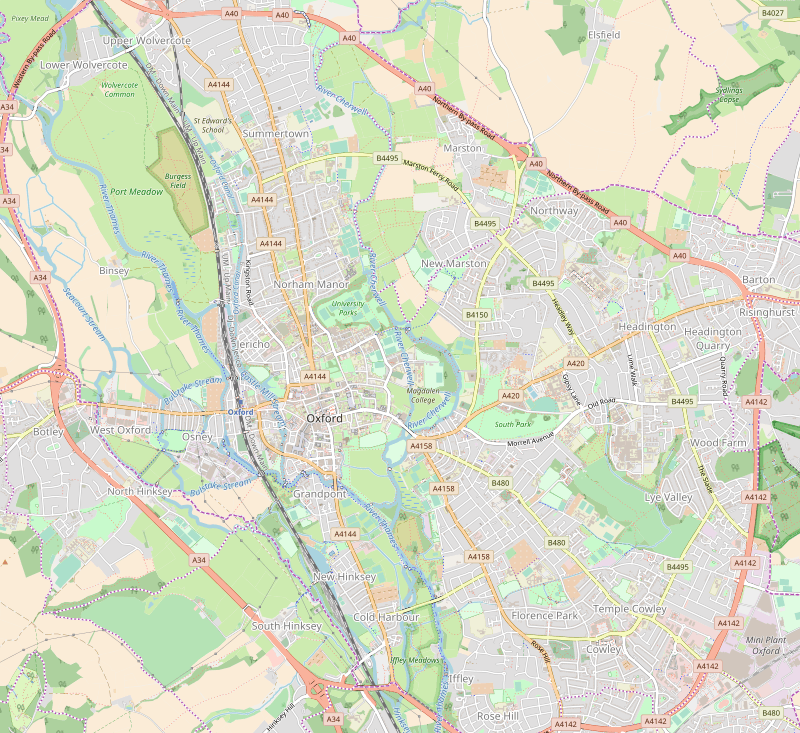
Aside from the city centre, there are several suburbs and neighbourhoods within the borders of the city of Oxford, including:
- Barton
- Blackbird Leys
- Cowley
- Temple Cowley
- Iffley
- Cutteslowe
- Headington
- Jericho
- North Oxford
- Osney
- Risinghurst
- Summertown
- Wolvercote
Suburbs and neighbourhoods outside the city boundaries include:
Green belt
Oxford is at the centre of the Oxford Green Belt, which is an environmental and planning policy that regulates the rural space in Oxfordshire surrounding the city which aims to prevent urban sprawl and minimize convergence with nearby settlements.[36] The policy has been blamed for the large rise in house prices in Oxford, making it the least affordable city in the UK outside London, with estate agents calling for brownfield land inside the green belt to be released for new housing.[37][38][39] The vast majority of area covered is outside the city, but there are some green spaces within that are covered by the designation such as much of the Thames and Cherwell river flood-meadows, and the village of Binsey, along with several smaller portions on the fringes. Other landscape features and places of interest covered include Cutteslowe Park and the mini railway attraction, the University Parks, Hogacre Common Eco Park, numerous sports grounds, Aston's Eyot, St Margaret's Church and well, and Wolvercote Common and community orchard.[40]
Economy
Oxford's economy includes manufacturing, publishing and science-based industries as well as education, research and tourism.
Car production
Oxford has been an important centre of motor manufacturing since Morris Motors was established in the city in 1910. The principal production site for Mini cars, owned by BMW since 2000, is in the Oxford suburb of Cowley. The plant, which survived the turbulent years of British Leyland in the 1970s and was threatened with closure in the early 1990s, also produced cars under the Austin and Rover brands following the demise of the Morris brand in 1984, although the last Morris-badged car was produced there in 1982.
Publishing
Oxford University Press, a department of the University of Oxford, is based in the city, although it no longer operates its own paper mill and printing house. The city is also home to the UK operations of Wiley-Blackwell, Elsevier and several smaller publishing houses.
Science and technology
The presence of the university has given rise to many science and technology based businesses, including Oxford Instruments, Research Machines and Sophos. The university established Isis Innovation in 1987 to promote technology transfer. The Oxford Science Park was established in 1990, and the Begbroke Science Park, owned by the university, lies north of the city.
Oxford increasingly has a reputation for being a centre of digital innovation, as epitomized by Digital Oxford.[41] Several startups including Passle,[42] Brainomix,[43] Labstep,[44] and more, are based in Oxford.
Education
The presence of the university has also led to Oxford becoming a centre for the education industry. Companies often draw their teaching staff from the pool of Oxford University students and graduates, and, especially for EFL education, use their Oxford location as a selling point.[45]
Brewing
There is a long history of brewing in Oxford. Several of the colleges had private breweries, one of which, at Brasenose, survived until 1889. In the 16th century brewing and malting appear to have been the most popular trades in the city. There were breweries in Brewer Street and Paradise Street, near the Castle Mill Stream.
The rapid expansion of Oxford and the development of its railway links after the 1840s facilitated expansion of the brewing trade.[46] As well as expanding the market for Oxford's brewers, railways enabled brewers further from the city to compete for a share of its market.[46] By 1874 there were nine breweries in Oxford and 13 brewers' agents in Oxford shipping beer in from elsewhere.[46] The nine breweries were: Flowers & Co in Cowley Road, Hall's St Giles Brewery, Hall's Swan Brewery (see below), Hanley's City Brewery in Queen Street, Le Mills's Brewery in St. Ebbes, Morrell's Lion Brewery in St Thomas Street (see below), Simonds's Brewery in Queen Street, Weaving's Eagle Brewery (by 1869 the Eagle Steam Brewery) in Park End Street and Wootten and Cole's St. Clement's Brewery.[46]
The Swan's Nest Brewery, later the Swan Brewery, was established by the early 18th century in Paradise Street, and in 1795 was acquired by William Hall.[47] The brewery became known as Hall's Oxford Brewery, which acquired other local breweries. Hall's Brewery was acquired by Samuel Allsopp & Sons in 1926, after which it ceased brewing in Oxford.[48]
Morrell's was founded in 1743 by Richard Tawney. He formed a partnership in 1782 with Mark and James Morrell, who eventually became the owners.[49] After an acrimonious family dispute this much-loved brewery was closed in 1998,[50] the beer brand names being taken over by the Thomas Hardy Burtonwood brewery,[51] while the 132 tied pubs were bought by Michael Cannon, owner of the American hamburger chain Fuddruckers, through a new company, Morrells of Oxford.[52] The new owners sold most of the pubs on to Greene King in 2002.[53] The Lion Brewery was converted into luxury apartments in 2002.[54]
Bellfounding
The Taylor family of Loughborough had a bell-foundry in Oxford between 1786 and 1854.[55]
Shopping

- Broad Street
- Clarendon Shopping Centre
- Cornmarket Street
- George Street
- Golden Cross
- The High Street
- Little Clarendon Street
- Queen Street, Oxford
- The Covered Market
- Turl Street
- Westgate Shopping Centre
- Gloucester Green
- Cowley Road
Outside the city centre:
- Banbury Road, Summertown, Oxford
- Botley Road, Oxford
- Cowley Retail Park, Cowley, Oxford
- Cowley Road, Oxford
- Iffley Road, Oxford
- London Road, Headington, Oxford
- North Parade, Oxford
- St Clement's, Oxford
- Templars Square shopping centre, Cowley, Oxford
- Walton Street, Jericho, Oxford
- New Botley
Landmarks
Oxford has numerous major tourist attractions, many belonging to the university and colleges. As well as several famous institutions, the town centre is home to Carfax Tower and the University Church of St Mary the Virgin, both of which offer views over the spires of the city. Many tourists shop at the historic Covered Market. In the summer punting on the Thames/Isis and the Cherwell is popular.
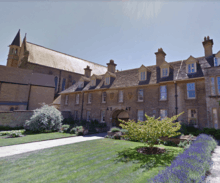
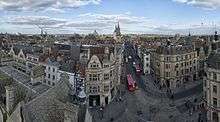
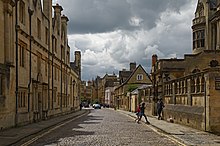
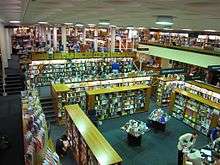
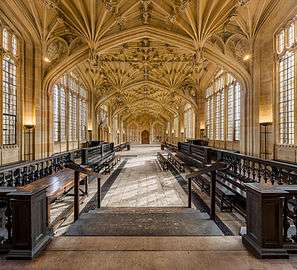
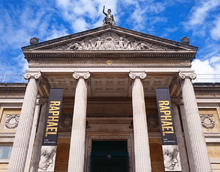
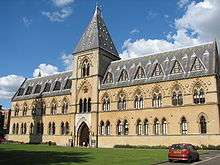
University of Oxford
The University of Oxford is the oldest university in the English-speaking world[56] and one of the most famous and prestigious higher education institutions of the world, averaging nine applications to every available place, and attracting 40% of its academic staff and 17% of undergraduates from overseas.[57] It is currently ranked as the world's number one university, according to The Times Higher Education World University Rankings.[58]
Oxford is renowned for its tutorial-based method of teaching, with students attending an average of one one-hour tutorial a week.[57]
The city centre
As well as being a major draw for tourists (9.1 million in 2008, similar in 2009),[59] Oxford city centre has many shops, several theatres and an ice rink. The historic buildings make this location a popular target for film and TV crews.
The city centre is relatively small, and is centred on Carfax, a crossroads which forms the junction of Cornmarket Street (pedestrianised), Queen Street (mainly pedestrianised), St Aldate's and the High Street ("the High"; blocked for through traffic). Cornmarket Street and Queen Street are home to Oxford's various chain stores, as well as a small number of independent retailers, one of the longest established of which is Boswell's, founded in 1738.[60] St Aldate's has few shops but several local government buildings, including the town hall, the city police station and local council offices. The High (the word street is traditionally omitted) is the longest of the four streets and has a number of independent and high-end chain stores, but mostly university and college buildings.
There are two small shopping malls in the city centre: The Clarendon Centre[61] and the Westgate Centre.[62] The Westgate Centre is named for the original West Gate in the city wall, and is at the west end of Queen Street. A major redevelopment and expansion to 750,000 sq ft (70,000 m2), with a new 230,000 sq ft (21,000 m2) John Lewis department store and a number of new homes, was completed in October 2017.
Blackwell's Bookshop is a large bookshop which claims the largest single room devoted to book sales in the whole of Europe, the cavernous Norrington Room (10,000 sq ft).[63]
The Bodleian Library
The University of Oxford maintains the largest university library system in the UK,[64] and, with over 11 million volumes housed on 120 miles (190 km) of shelving, the Bodleian group is the second-largest library in the UK, after the British Library. The Bodleian is a legal deposit library, which means that it is entitled to request a free copy of every book published in the UK. As such, its collection is growing at a rate of over three miles (five kilometres) of shelving every year.[65]
Visitors can take a guided tour of the Old Bodleian Library to see inside its historic rooms, including the 15th-century Divinity School, medieval Duke Humfrey's Library, and the Radcliffe Camera. The Weston Library was redeveloped and reopened in 2015, with a new shop, café and exhibition galleries for visitors.[66]
Museums and galleries
Oxford is home to many museums, galleries, and collections, most of which are free of admission charges and are major tourist attractions. The majority are departments of the University of Oxford.
The first of these to be established was the Ashmolean Museum, the world's first university museum,[67] and the oldest museum in the UK.[68] Its first building was erected in 1678–1683 to house a cabinet of curiosities given to the University of Oxford in 1677. The museum reopened in 2009 after a major redevelopment. It holds significant collections of art and archaeology, including works by Michelangelo, Leonardo da Vinci, Turner, and Picasso, as well as treasures such as the Scorpion Macehead, the Parian Marble and the Alfred Jewel. It also contains "The Messiah", a pristine Stradivarius violin, regarded by some as one of the finest examples in existence.[69]
The University Museum of Natural History holds the University's zoological, entomological and geological specimens. It is housed in a large neo-Gothic building on Parks Road, in the University's Science Area.[70][71] Among its collection are the skeletons of a Tyrannosaurus rex and Triceratops, and the most complete remains of a dodo found anywhere in the world. It also hosts the Simonyi Professorship of the Public Understanding of Science, currently held by Marcus du Sautoy.
Adjoining the Museum of Natural History is the Pitt Rivers Museum, founded in 1884, which displays the University's archaeological and anthropological collections, currently holding over 500,000 items. It recently built a new research annexe; its staff have been involved with the teaching of anthropology at Oxford since its foundation, when as part of his donation General Augustus Pitt Rivers stipulated that the University establish a lectureship in anthropology.[72]
The Museum of the History of Science is housed on Broad St in the world's oldest-surviving purpose-built museum building.[73] It contains 15,000 artefacts, from antiquity to the 20th century, representing almost all aspects of the history of science.
In the University's Faculty of Music on St Aldate's is the Bate Collection of Musical Instruments, a collection mostly of instruments from Western classical music, from the medieval period onwards. Christ Church Picture Gallery holds a collection of over 200 old master paintings. The University also has an archive at the Oxford University Press Museum.[74]
Other museums and galleries in Oxford include Modern Art Oxford, the Museum of Oxford, the Oxford Castle, and The Story Museum.[75]
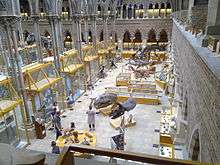 Galleries at the Museum of Natural History
Galleries at the Museum of Natural History- Museum of the History of Science
 The Pitt Rivers Museum
The Pitt Rivers Museum
Other attractions
- Christ Church Cathedral, Oxford
- The Headington Shark
- Oxford University Press
- Oxford Botanic Garden
- Sheldonian Theatre
- St. Mary the Virgin Church
- Radcliffe Observatory
- Oxford Oratory
- Malmaison Hotel, located in a converted prison in part of the medieval Oxford Castle
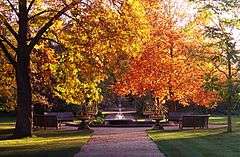 Oxford Botanic Garden
Oxford Botanic Garden
.jpg)
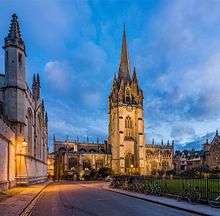 The University Church of St Mary the Virgin
The University Church of St Mary the Virgin
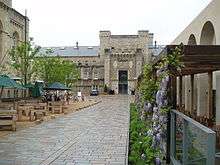 Oxford Malmaison Hotel
Oxford Malmaison Hotel
Parks and nature walks
Oxford is a very green city, with several parks and nature walks within the ring road, as well as several sites just outside the ring road. In total, 28 nature reserves exist within or just outside Oxford ring road, including:
- University Parks
- Mesopotamia
- Rock Edge Nature Reserve
- Lye Valley
- South Park
- C. S. Lewis Nature Reserve
- Shotover Nature Reserve
- Port Meadow
- Cutteslowe Park
Transport
Air
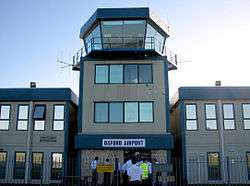
In addition to the larger airports in the region, Oxford is served by nearby Oxford Airport, in Kidlington. The airport is also home to CAE Oxford Aviation Academy and Airways Aviation[76] airline pilot flight training centres, and several private jet companies. The airport is also home to Airbus Helicopters UK headquarters.[77]
Buses
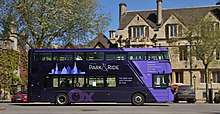
Bus services in Oxford and its suburbs are run by the Oxford Bus Company and Stagecoach Oxfordshire as well as other operators including Arriva Shires & Essex and Thames Travel.
Arriva Shires & Essex operates Sapphire route 280 to Aylesbury via Wheatley, Thame and Haddenham seven days a week, at a frequency of up to every 20 minutes.[78] The new Sapphire buses have three-pin power sockets, leather seats and free, onboard Wi-Fi.[79]
Oxford has five park and ride car parks with frequent bus links to the city centre:
- Pear Tree (bus 300)
- Redbridge (bus 300)
- Seacourt (bus 400)
- Thornhill (bus 400)
- Water Eaton and Oxford Parkway (bus 500)
There are also bus services to the John Radcliffe Hospital (from Thornhill and Water Eaton/Oxford Parkway) and to the Churchill and Nuffield Hospitals (from Thornhill). As of 2015, Oxford has one of the largest urban park and ride networks in the UK. Its five sites have a combined capacity of 4,930 car parking spaces,[80] served by 20 Oxford Bus Company double deck buses with a combined capacity of 1,695 seats.[81] By comparison, York park and ride has six sites with a combined total of 4,970 parking spaces[82] served by 35 First York buses, but they are single deckers with a combined capacity of 1,548 seats.[83]
.jpg)
More than 58% of Oxford Bus Company customers use the ITSO Ltd smartcard. Secondary school students are able to gain either a reduced price pass, like pay a set fee for the month, or a free riding pass for the school year.[84]
In November 2014 all Oxford Bus Company buses within the Oxford SmartZone area have free WiFi installed.[85][86][87]
Hybrid buses, which use battery power with a small diesel generator, began to be used in Oxford on 15 July 2010, on Stagecoach Oxfordshire's Route 1 (City centre – Cowley – Blackbird Leys). Both Stagecoach and Oxford Bus Company now operate numerous hybrid buses in the city.[88] In 2014 Oxford Bus introduced a fleet of 20 new buses with flywheel energy storage (FES) on the services it operates under contract for Brookes University.[89] Whereas electric hybrids use battery storage and an electric motor to save fuel, FES uses a high-speed flywheel.
Coach
The Oxford to London coach route offers a frequent coach service to London. The Oxford Tube is operated by Stagecoach Oxfordshire and the Oxford Bus Company runs the Airline services to Heathrow and Gatwick airports.
There is a bus station at Gloucester Green, used mainly by the London and airport buses, National Express coaches and other long-distance buses including route X5 to Milton Keynes and Cambridge and Stagecoach Gold routes S1, S2, S3, S4, S5, S8 and S9.
Cycling
Among UK cities, Oxford has the second highest percentage of people cycling to work.[90]
Rail
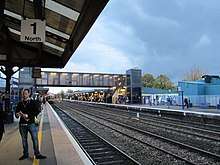
In 1844, the Great Western Railway linked Oxford with London Paddington via Didcot and Reading;[20][21] in 1851, the London and North Western Railway opened its own route from Oxford to London Euston, via Bicester, Bletchley and Watford;[91] and in 1864 a third route, also to Paddington, running via Thame, High Wycombe and Maidenhead, was provided;[92] this was shortened in 1906 by the opening of a direct route between High Wycombe and London Paddington by way of Denham.[93] The distance from Oxford to London was 78 miles (125.5 km) via Bletchley; 63.5 miles (102.2 km) via Didcot and Reading; 63.25 miles (101.8 km) via Thame and Maidenhead;[94] and 55.75 miles (89.7 km) via Denham.[93] Only the original (Didcot) route is still in use for its full length, portions of the others remain.
There were also routes to the north and west. The line to Banbury was opened in 1850,[95] and was extended to Birmingham Snow Hill in 1852;[96] a route to Worcester opened in 1853.[97] A branch to Witney was opened in 1862,[98] which was extended to Fairford in 1873.[99] The line to Witney and Fairford closed in 1962, but the others remain open.
Oxford has had three main railway stations. The first was opened at Grandpont in 1844,[100] but this was a terminus, inconvenient for routes to the north;[95] it was replaced by the present station on Park End Street in 1852 with the opening of the Birmingham route.[96] Another terminus, at Rewley Road, was opened in 1851 to serve the Bletchley route;[101] this station closed in 1951.[102] There have also been a number of local railway stations, all of which are now closed. A fourth station, Oxford Parkway, is just outside the city, at the park and ride site near Kidlington.
Oxford railway station is half a mile (about 1 km) west of the city centre. The station is served by CrossCountry services to Bournemouth, Manchester Piccadilly and Newcastle, Great Western Railway (who manage the station) services to London Paddington, Banbury and Hereford and Chiltern Railways services to London Marylebone.
The present railway station opened in 1852. Oxford is the junction for a short branch line to Bicester, a remnant of the former Varsity line to Cambridge. This Oxford–Bicester line was upgraded to 100 mph (161 km/h) running during an 18-month closure in 2014/2015 – and is scheduled to be extended to form the planned East West Rail line to Cambridge.[103] Chiltern Railways now connects Oxford to London Marylebone via Bicester Village, having sponsored the building of about 400 metres of new track between Bicester Village and the Chiltern Main Line southwards in 2014. The route serves High Wycombe and London Marylebone, avoiding London Paddington and Didcot Parkway. East West Rail is proposed to continue through Bletchley (for Milton Keynes Central) to Bedford,[104] Cambridge,[105] and ultimately Ipswich and Norwich,[106] thus providing alternative route to East Anglia without needing to travel via, and connect between, the London mainline terminals.
Rail–airport links
From Oxford station direct trains run to London Paddington where interchange with the Heathrow Express train links with Heathrow Airport. Passengers can change at Reading for connecting trains to Gatwick Airport. Some CrossCountry trains run direct services to Birmingham International as well as further afield Southampton Airport Parkway.
River and canal
Oxford was historically an important port on the River Thames, with this section of the river being called the Isis; the Oxford-Burcot Commission in the 17th century attempted to improve navigation to Oxford.[107] Iffley Lock and Osney Lock lie within the bounds of the city. In the 18th century the Oxford Canal was built to connect Oxford with the Midlands.[108]
Commercial traffic has given way to recreational use of the river and canal. Oxford was the original base of Salters Steamers (founded in 1858), which was a leading racing-boat-builder that played an important role in popularising pleasure boating on the Upper Thames. The firm runs a regular service from Folly Bridge downstream to Abingdon and beyond.
Roads
Oxford's central location on several transport routes means that it has long been a crossroads city with many coaching inns, although road traffic is now strongly discouraged from using the city centre. From 2020, a new Zero Emission Zone will mean any vehicles which are not zero-emission will be banned from the city centre during certain hours.[109]
The Oxford Ring Road surrounds the city centre and close suburbs Marston, Iffley, Cowley and Headington; it consists of the A34 to the west, a 330-yard section of the A44, the A40 north and north-east, A4142/A423 to the east. It is a dual carriageway, except for a 330-yard section of the A40 where two residential service roads adjoin, and was completed in 1966.
A roads
The main roads to/from Oxford are:
- A34 – a trunk route connecting the North and Midlands to the port of Southampton. It leaves J9 of the M40 north of Oxford, passes west of Oxford to Newbury and Winchester to the south and joins the M3 12.7 miles (20.4 km) north of Southampton. Since the completion of the Newbury bypass in 1998, this section of the A34 has been an entirely grade separated dual carriageway. Historically the A34 led to Bicester, Banbury, Stratford-upon-Avon, Birmingham and Manchester, but since the completion of the M40 it disappears at J9 and re-emerges 50 miles (80 km) north at Solihull.
- A40 – leading east dualled to J8 of the M40 motorway, then an alternative route to High Wycombe and London; leading west part-dualled to Witney then bisecting Cheltenham, Gloucester, Monmouth, Abergavenny, passing Brecon, Llandovery, Carmarthen and Haverfordwest to reach Fishguard.
- A44 – which begins in Oxford, leading past Evesham to Worcester, Hereford and Aberystwyth.
- A420 – which also begins in Oxford and leads to Bristol passing Swindon and Chippenham.
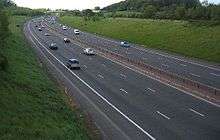
Motorway
The city is served by the M40 motorway, which connects London to Birmingham. The M40 approached Oxford in 1974, leading from London to Waterstock, where the A40 continued to Oxford. When the M40 extension to Birmingham was completed in January 1991, it curved sharply north, and a mile of the old motorway became a spur. The M40 comes no closer than 6 miles (9.7 km) away from the city centre, curving to the east of Otmoor. The M40 meets the A34 to the north of Oxford.
Education
Schools
Universities and colleges
There are two universities in Oxford, the University of Oxford and Oxford Brookes University, as well as the specialist further and higher education institution Ruskin College that is an Affiliate of the University of Oxford. The Islamic Azad University also has a campus near Oxford.
Media
As well as the BBC national radio stations, Oxford and the surrounding area has several local stations, including BBC Oxford, Heart Thames Valley, Destiny 105, Jack FM and Jack FM 2 along with Oxide: Oxford Student Radio[110] (which went on terrestrial radio at 87.7 MHz FM in late May 2005). A local TV station, Six TV: The Oxford Channel, was also available[111] but closed in April 2009; a service operated by That's TV, originally called That's Oxford (now That's Oxfordshire), took to the airwaves in 2015.[112][113] The city is home to a BBC TV newsroom which produces an opt-out from the main South Today programme broadcast from Southampton.
Popular local papers include The Oxford Times (compact; weekly), its sister papers the Oxford Mail (tabloid; daily) and the Oxford Star (tabloid; free and delivered), and Oxford Journal (tabloid; weekly free pick-up). Oxford is also home to several advertising agencies.
Daily Information (known locally as Daily Info) is an events and advertising news sheet which has been published since 1964 and now provides a connected website.
Nightshift is a monthly local free magazine that has covered the Oxford music scene since 1991.[114]
In 2003 DIY grassroots non-corporate media has begun to spread.[115] Independent and community newspapers include the Jericho Echo[116] and Oxford Prospect.[117]
Culture
Theatres and cinemas
- Burton Taylor Studio, Gloucester Street
- New Theatre, George Street
- Odeon Cinema, George Street
- Odeon Cinema, Magdalen Street
- Curzon Cinema, Westgate, Bonn Square
- Old Fire Station Theatre, George Street
- O'Reilly Theatre, Blackhall Road
- Oxford Playhouse, Beaumont Street
- Pegasus Theatre,[118] Magdalen Road
- Phoenix Picturehouse, Walton Street
- Ultimate Picture Palace, Cowley Road
- Vue Cinema Grenoble Road
- The North Wall Arts Centre, South Parade
- Creation Theatre Company
Literature and film
Well-known Oxford-based authors include:
- Brian Aldiss, who lived in Oxford.
- Vera Brittain, undergraduate at Somerville.
- John Buchan, 1st Baron Tweedsmuir, attended Brasenose College. Best known for his The Thirty-nine Steps, authored 32 novels and many more volumes of history, poetry and essays.
- A.S. Byatt, undergraduate at Somerville.
- Susan Cooper, undergraduate at Somerville, best known for her The Dark Is Rising Sequence.
- Lewis Carroll (real name Charles Lutwidge Dodgson), Student and Mathematical Lecturer of Christ Church.
- Colin Dexter, who wrote and set his Inspector Morse detective novels in Oxford.
- John Donaldson (d. 1989), a poet resident in Oxford in later life.
- Siobhan Dowd, Oxford resident, who was an undergraduate at Lady Margaret Hall, Oxford.
- Victoria Glendinning, undergraduate at Somerville.
- Kenneth Grahame, educated at St Edward's School, Oxford.
- Michael Innes (J. I. M. Stewart), of Christ Church.
- P. D. James, born and died in Oxford.
- T. E. Lawrence, "Lawrence of Arabia", Oxford resident, undergraduate at Jesus, postgraduate at Magdalen.
- C. S. Lewis, student at University College and Fellow of Magdalen.
- Iris Murdoch, undergraduate at Somerville and fellow of St Anne's.
- Carola Oman, novelist and biographer, was born and brought up in the city.
- Iain Pears, undergraduate at Wadham and Oxford resident, whose novel An Instance of the Fingerpost is set in the city.
- Philip Pullman, undergraduate at Exeter, teacher and resident in the city.
- Dorothy L. Sayers, undergraduate at Somerville.
- J. R. R. Tolkien, undergraduate at Exeter and later professor of English at Merton
- John Wain, undergraduate at St John's and later Professor of Poetry at Oxford University 1973–78
- Oscar Wilde, a 19th-century poet and author who attended Oxford from 1874 to 1878.
- Charles Williams, editor at Oxford University Press.
Oxford appears in the following works:
- The Scarlet Pimpernel
- "Harry Potter" (all the films to date)
- The Chronicles of the Imaginarium Geographica by James A. Owen
- Jude the Obscure (1895) by Thomas Hardy (in which Oxford is thinly disguised as "Christminster").
- Zuleika Dobson (1911) by Max Beerbohm.
- Gaudy Night (1935) by Dorothy L. Sayers.
- Brideshead Revisited (1945) by Evelyn Waugh.
- A Question of Upbringing (1951 ) by Anthony Powell
- Second Generation (1964 novel) by Raymond Williams
- Young Sherlock Holmes (1985) by Steven Spielberg
- Inspector Morse (1987)
- Where the Rivers Meet (1988) trilogy set in Oxford by John Wain
- All Souls (1989) by Javier Marías
- The Children of Men (1992) by P. D. James.
- Doomsday Book (1992) by Connie Willis
- His Dark Materials (1995 onwards) by Philip Pullman
- Tomorrow Never Dies (1997)
- The Saint (1997)
- 102 Dalmatians (2000)
- Endymion Spring (2006) by Matthew Skelton
- Lewis (2006–15)
- The Oxford Murders (2008)
- Mr. Nice (2010) The story of Howard Marks
- A Discovery of Witches (2011) Deborah Harkness
- X-Men: First Class (2011)
- Endeavour (2012)
- The Reluctant Cannibals (2013) by Ian Flitcroft
- Mamma Mia! Here We Go Again (2018)
Music
Holywell Music Room is said to be the oldest purpose-built music room in Europe, and hence Britain's first concert hall.[119] Tradition has it that George Frideric Handel performed there, though there is little evidence.[120] Joseph Haydn was awarded an honorary doctorate by Oxford University in 1791, an event commemorated by three concerts of his music at the Sheldonian Theatre, directed by the composer and from which his Symphony No. 92 earned the nickname of the "Oxford" Symphony.[121] Victorian composer Sir John Stainer was organist at Magdalen College and later Professor of Music at the university, and is buried in Holywell Cemetery.[122]
Oxford, and its surrounding towns and villages, have produced many successful bands and musicians in the field of popular music. The most notable Oxford act is Radiohead, who all met at nearby Abingdon School, though other well known local bands include Supergrass, Ride, Swervedriver, Lab 4, Talulah Gosh, the Candyskins, Medal, the Egg, Unbelievable Truth, Hurricane No. 1, Crackout, Goldrush and more recently, Young Knives, Foals, Glass Animals, Dive Dive and Stornoway. These and many other bands from over 30 years of the Oxford music scene's history feature in the documentary film Anyone Can Play Guitar?. In 1997, Oxford played host to Radio 1's Sound City, with acts such as Travis, Bentley Rhythm Ace, Embrace, Spiritualized and DJ Shadow playing in various venues around the city including Oxford Brookes University.[123]
It is also home to several brass bands, notably the City of Oxford Silver Band, founded in 1887.
Sport
Football
The city's leading football club, Oxford United, are currently in League One, the third tier of league football, though they enjoyed some success in the past in the upper reaches of the league. They were elected to the Football League in 1962, reached the Third Division after three years and the Second Division after six, and most notably reached the First Division in 1985 – 23 years after joining the Football League. They spent three seasons in the top flight, winning the Football League Cup a year after promotion. The 18 years that followed relegation in 1988 saw their fortunes decline gradually, though a brief respite in 1996 saw them win promotion to the new (post Premier League) Division One in 1996 and stay there for three years. They were relegated to the Football Conference in 2006, staying there for four seasons before returning to the Football League in 2010. They play at the Kassam Stadium (named after former chairman Firoz Kassam), which is near the Blackbird Leys housing estate and has been their home since relocation from the Manor Ground in 2001. The club's notable former managers include Ian Greaves, Jim Smith, Maurice Evans, Brian Horton, Ramon Diaz and Denis Smith. Notable former players include John Aldridge, Ray Houghton, Tommy Caton, Matt Elliott, Dean Saunders and Dean Whitehead.
Oxford City F.C. is a semi-professional football club, separate from Oxford United. It plays in the Conference South, the sixth tier, two levels below the Football League in the pyramid. Oxford City Nomads F.C. was a semi-professional football club who ground-shared with Oxford City and played in the Hellenic league.
Rugby league
In 2013, Oxford Rugby League entered rugby league's semi-professional Championship 1, the third tier of British rugby league. Oxford Cavaliers, who were formed in 1996, compete at the next level, the Conference League South. Oxford University (The Blues)[124] and Oxford Brookes University (The Bulls)[125] both compete in the rugby league BUCS university League.
Rugby union
Oxford Harlequins RFC is the city's main Rugby Union team and currently plays in the South West Division.
Oxford R.F.C is the oldest city team and currently plays in the Berks, Bucks and Oxon Championship. Their most famous player was arguably Michael James Parsons known as Jim Parsons who was capped by England.[126]
Oxford University RFC are the most famous club with more than 300 Oxford players gaining International honours; including Phil de Glanville, Joe Roff, Tyrone Howe, Anton Oliver, Simon Halliday, David Kirk and Rob Egerton.[127]
London Welsh RFC moved to the Kassam Stadium in 2012 to fulfil their Premiership entry criteria regarding stadium capacity. At the end of the 2015 season, following relegation, the club left Oxford.[128]
Speedway and greyhound racing
Oxford Cheetahs motorcycle speedway team has raced at Oxford Stadium in Cowley on and off since 1939. The Cheetahs competed in the Elite League and then the Conference League until 2007. They were Britain's most successful club in the late 1980s, becoming British League champions in 1985, 1986 and 1989. Four-times world champion Hans Nielsen was the club's most successful rider.
Greyhound racing took place at the Oxford Stadium from 1939 until 2012 and hosted some of the sport's leading events such as the Pall Mall Stakes, The Cesarewitch and Trafalgar Cup. The stadium remains intact but unused after closing in 2012.
Hockey
There are several hockey clubs based in Oxford. The Oxford Hockey Club (formed after a merger of City of Oxford HC and Rover Oxford HC in 2011) plays most of its home games on the pitch at Oxford Brookes University, Headington Campus and also uses the pitches at Headington Girls' School and Iffley Road. Oxford Hawks has two astroturf pitches at Banbury Road North, by Cutteslowe Park to the north of the city.
Ice hockey
Oxford City Stars is the local Ice Hockey Team which plays at Oxford Ice Rink. There is a senior/adults’ team[129] and a junior/children's team.[130] The Oxford University Ice Hockey Club was formed as an official University sports club in 1921, and traces its history back to a match played against Cambridge in St Moritz, Switzerland in 1885.[131] The club currently competes in Checking Division 1 of the British Universities Ice Hockey Association.[132]
American football
Oxford Saints is Oxford's senior American Football team. One of the longest running American football clubs in the UK, the Saints were founded in 1983 and have competed for over 30 years against other British teams across the country.
Cricket
Oxford University Cricket Club is Oxford's most famous club with more than 300 Oxford players gaining international honours, including Colin Cowdrey, Douglas Jardine and Imran Khan.[133]
Oxfordshire County Cricket Club play in the Minor Counties League.
Rowing
Oxford University Boat Club compete in the world-famous Boat Race. Since 2007 the club has been based at a training facility and boathouse in Wallingford,[134] south of Oxford, after the original boathouse burnt down in 1999. Oxford is also home to the City of Oxford Rowing Club, based near Donnington Bridge.
Other sports
Headington Road Runners based at the OXSRAD sports facility in Marsh Lane (next to Oxford City F.C.) is Oxford's only road running club with an average annual membership exceeding 300. It was the club at which double Olympian Mara Yamauchi started her running career.
International relations
Oxford is twinned with:
Gallery
 Sheldonian Theatre in 2009
Sheldonian Theatre in 2009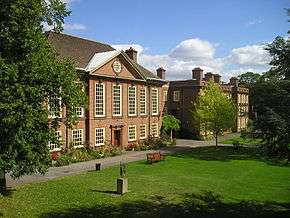 Somerville College, one of the constituent colleges of the University of Oxford
Somerville College, one of the constituent colleges of the University of Oxford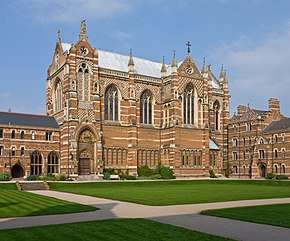 Keble College, one of the constituent colleges of the University of Oxford
Keble College, one of the constituent colleges of the University of Oxford Night view of High Street with Christmas lights - one of Oxford's main streets
Night view of High Street with Christmas lights - one of Oxford's main streets Floral display in Oxford city centre in 2001
Floral display in Oxford city centre in 2001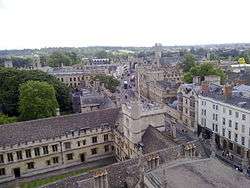 All Souls' College looking east up the High Street from St Mary's Church
All Souls' College looking east up the High Street from St Mary's Church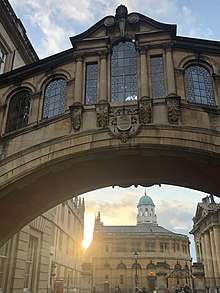 The Bridge of Sighs links sections of Hertford College: as seen from New College Lane with the Sheldonian Theatre in the background.
The Bridge of Sighs links sections of Hertford College: as seen from New College Lane with the Sheldonian Theatre in the background.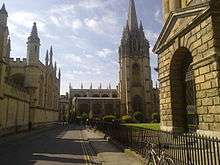 University Church of St Mary the Virgin as seen from Radcliffe Square.
University Church of St Mary the Virgin as seen from Radcliffe Square.- Broad Street, showing the main entrances to Trinity and Balliol Colleges, and obliquely, the frontage of Exeter College from the Sheldonian Theatre.
 Carfax Tower at Carfax, the junction of the High Street, Queen Street, Cornmarket and St Aldate's streets at what is considered by many to be the centre of the city.
Carfax Tower at Carfax, the junction of the High Street, Queen Street, Cornmarket and St Aldate's streets at what is considered by many to be the centre of the city.- High Street as viewed from St Mary's, looking east, with Magdalen College in the distant background.
 Merton College Chapel and Corpus Christi College as viewed from the Oriel Square entrance to Merton Street.
Merton College Chapel and Corpus Christi College as viewed from the Oriel Square entrance to Merton Street.
Freedom of the City
The following people and military units have received the Freedom of the City of Oxford.
Individuals
- Admiral Rt Hon Lord Nelson KB: 22 July 1802.
- Rt Hon Lord Valentia KCVO CB JP: 6 December 1900.
- Admiral of the Fleet Sir Reginald Tyrwhitt GCB DSO: 3 February 1919.
- Admiral of the Fleet Rt Hon Lord Beatty GCB OM GCVO DSO PC: 25 June 1919.
- Field Marshal Rt Hon Lord Haig KT GCB OM GCVO KCIE: 25 June 1919.
- Sir Michael Sadler KCSI CB: 18 May 1931.
- Benjamin R. Jones: 4 September 1942.
- Rt Hon Lord Nuffield GBE CH FRS: 15 January 1951.
- Rt Hon Sir Robert Menzies KT AK CH FAA FRS QC: 6 June 1953.
- Alic Halford Smith: 10 February 1955.
- Rt Hon Lord Bicester: 1 March 1955.
- Rt Hon Lord Attlee KG OM CH PC FRS: 16 January 1956.
- Sir Basil Blackwell: 12 January 1970.
- Olive Gibbs DL: 17 June 1982.
- Nelson Mandela: 23 June 1997.
- Aung San Suu Kyi: 15 December 1997 (Revoked by Oxford City Council on 27 November 2017).
- Colin Dexter OBE: 26 February 2001.
- Professor Sir Richard Doll CH OBE FRS: 16 September 2002.
- Sir Roger Bannister CH CBE FRCP: 12 May 2004.
- Sir Philip Pullman CBE FRSL: 24 January 2007.
- Professor Christopher Brown CBE: 2 July 2014.
- Benny Wenda: 17 July 2019.[142]
Military units
- Oxfordshire and Buckinghamshire Light Infantry: 1 October 1945.
- 1st Green Jackets (43rd and 52nd): 7 November 1958.
- Royal Green Jackets: 1 January 1966.
- The Rifles: 1 February 2007.[144]
See also
- Bishop of Oxford
- Earl of Oxford
- List of attractions in Oxford
- List of Oxford architects
- Mayors of Oxford
- Oxfam
- Oxford bags
- The Oxfordian Age – a subdivision of the Jurassic Period named for Oxford
References
Citations
- "Key Facts about Oxford". Oxford City Council. Archived from the original on 29 June 2018. Retrieved 4 January 2019.
- UK Census (2011). "Local Area Report – Oxford Local Authority (1946157324)". Nomis. Office for National Statistics. Retrieved 9 February 2018.
- Upton, Clive; et al., eds. (2001). The Oxford Dictionary of Pronunciation for Current English. Oxford, England: Oxford University Press. p. 734. ISBN 978-0-19-863156-9.
- Dictionary.com, "oxford" in Dictionary.com Unabridged. Source location: Random House, Inc. http://dictionary.reference.com/browse/oxford Archived 23 June 2012 at the Wayback Machine. Available: http://dictionary.reference.com Archived 20 May 2015 at the Wayback Machine. Accessed: 4 July 2012.
- Sager 2005, p. 36.
- Margaret Gelling, The Place-Names of Oxfordshire, Part 1, ISBN 0-521-04916-4
- "A Handy Guide to Oxford, ch. 2". Penelope.uchicago.edu. Retrieved 17 April 2010.
- "The St Brice's Day Massacre". History Today Volume 52 Issue 11 November 2002. Archived from the original on 22 September 2017. Retrieved 25 June 2017.
- Ord, Louise (12 August 2011). "Oxford Viking massacre revealed by skeleton find". BBC News. bbc.com. Archived from the original on 20 August 2017. Retrieved 25 June 2017.
- "When Vikings put Oxford to the torch". The Oxford Times 10 February 2010. Archived from the original on 27 October 2017. Retrieved 25 June 2017.
- Chris Andrews, David Huelin; Oxford. Introduction & Guide; Oxford 1986
- "The Jewish Community of Oxford". The Museum of the Jewish People at Beit Hatfutsot. Archived from the original on 2 July 2018. Retrieved 2 July 2018.
- Crouch, D. (2013). The Reign of King Stephen: 1135–1154 (2nd ed.). London: Routledge. p. 203. ISBN 978-1-31789-297-7.
- "Oxford charter 1191". whatdotheyknow.com. 23 July 2008. Archived from the original on 2 August 2009. Retrieved 17 April 2010.
- Eleanor Chance, Christina Colvin, Janet Cooper, C J Day, T G Hassall, Mary Jessup and Nesta Selwyn (1979). "Boundaries". In Alan Crossley; C R Elrington (eds.). A History of the County of Oxford: Volume 4, the City of Oxford. Victoria County History. pp. 260–264. Archived from the original on 1 January 2016. Retrieved 30 December 2015.CS1 maint: uses authors parameter (link)
- Jenkins, Vivian (1996). Kings & Queens. HarperCollins. ISBN 0-00-472295-7.
- "The Sweating Sickness". Story of London. Archived 28 July 2011 at the Wayback Machine
- "Ridley, Latimer, and Cranmer: the Oxford Martyrs". Westminster Seminary California. Archived from the original on 25 May 2014. Retrieved 25 May 2014.
- Cockayne, Emily (2007). Hubbub: Filth Noise & Stench in England. Yale University Press. pp. 134–136. ISBN 978-0-300-13756-9.
- Simpson 1997, p. 59.
- Simpson 2001, p. 9.
- "Cowley Barracks". Headington at War. Archived from the original on 8 November 2014. Retrieved 7 November 2014.
- Harrison, Brian, ed. (1994). History of the University of Oxford: Volume VIII: The Twentieth Century – Oxford Scholarship. Oxford University Press. doi:10.1093/acprof:oso/9780198229742.001.0001. ISBN 9780198229742. Archived from the original on 17 November 2015. Retrieved 10 November 2015.
- "Oxford Business Group Country Reports". hbs.edu. Archived from the original on 30 July 2012. Retrieved 25 July 2012.
- "Exhibition remembers refugees who fled to Oxford before and during World War II". Archived from the original on 21 October 2012.
- Neil Harvey. "College life in wartime". ox.ac.uk. Archived from the original on 15 May 2009.
- "1954: Bannister breaks four-minute mile". bbc.co.uk. Archived from the original on 7 March 2008. Retrieved 25 May 2014.
- Oxford Brookes University, 'Awards and Rankings' Archived 6 September 2013 at the Wayback Machine. Retrieved 19 August 2013.
- "Ethnicity". Oxford City Council. Archived from the original on 20 December 2019. Retrieved 5 February 2020.
- "Daily Data from the Radcliffe Observatory site in Oxford". University of Oxford. Retrieved 24 June 2020.
- "Radcliffe Meteorological Station". Archived from the original on 1 June 2008. Retrieved 17 March 2008.
- "Monthly, Annual and Seasonal Data from the Radcliffe Observatory site in Oxford". University of Oxford. Retrieved 24 June 2020.
- "Oxford 1981–2010 averages". Met Office. Retrieved 5 April 2019.
- "Daily Data from the Radcliffe Observatory site in Oxford". University of Oxford. Retrieved 23 June 2020.
- "Ethnicity". Oxford City Council. Archived from the original on 12 August 2018. Retrieved 11 August 2018.
- "CPRE:The Oxford Green Belt: Key Facts". www.cpreoxon.org.uk. Archived from the original on 15 February 2018. Retrieved 15 February 2018.
- "Estate agents call for building on Green Belt to ease house price crisis". Oxford Mail. Archived from the original on 26 April 2019. Retrieved 30 May 2019.
- Elledge, Jonn (22 September 2017). "Loosen Britain's green belt. It is stunting our young people – Jonn Elledge". The Guardian. Archived from the original on 27 May 2019. Retrieved 30 May 2019 – via www.theguardian.com.
- White, Anna (26 February 2015). "Welcome to Britain's most unaffordable spot – it's not London". Archived from the original on 26 April 2019. Retrieved 30 May 2019 – via www.telegraph.co.uk.
- "Oxford Green Belt Study Final Report Prepared by LUC October 2015" (PDF). oxfordshire.gov.uk. Archived (PDF) from the original on 15 February 2018. Retrieved 15 February 2018.
- "Home – Digital Oxford". Digital Oxford. Archived from the original on 9 May 2015. Retrieved 3 June 2015.
- "Passle – become a thought leader". Passle: Don't have time to blog?. Retrieved 3 June 2015.
- "Brainomix". Brainomix. Archived from the original on 8 July 2015. Retrieved 5 June 2015.
- "Labstep". angel.co. Archived from the original on 3 June 2015. Retrieved 3 June 2015.
- "Learn English in Oxford". oxford-royale.co.uk. Archived from the original on 23 May 2014. Retrieved 25 May 2014.
- Woolley, Liz (2010). "Industrial Architecture in Oxford, 1870 to 1914". Oxoniensia. Oxfordshire Architectural and Historical Society. LXXV: 78. ISSN 0308-5562.
- Page, William, ed. (1907). A History of the County of Oxford, Volume 2: Industries: Malting and Brewing. Victoria County History. Archibald Constable & Co. pp. 225–277. Archived from the original on 16 March 2012. Retrieved 5 February 2011.
- Richmond, Lesley; Turton, Alison (1990). The Brewing industry: a guide to historical records. p. 165. ISBN 978-0-7190-3032-1. Archived from the original on 21 September 2015. Retrieved 27 June 2015.
- "History of Headington, Oxford". Headington.org.uk. 19 April 2009. Archived from the original on 23 March 2010. Retrieved 17 April 2010.
- "Morrells Brewery up for sale". Archive.thisisoxfordshire.co.uk. Archived from the original on 1 December 2008. Retrieved 17 April 2010.
- www.quaffale.org.uk (22 September 2001). "Morrells Brewery Ltd". Quaffale.org.uk. Archived from the original on 22 November 2008. Retrieved 17 April 2010.
- "Jericho Echo". Pstalker.com. Archived from the original on 8 August 2010. Retrieved 17 April 2010.
- "England | Brewer buys pub chain for £67m". BBC News. 18 June 2002. Archived from the original on 12 January 2009. Retrieved 17 April 2010.
- "Brewery site plan nears final hurdle". Archive.thisisoxfordshire.co.uk. 19 February 2001. Archived from the original on 25 December 2008. Retrieved 17 April 2010.
- "Bell Founders". Dove's Guide for Church Bell Ringers. Archived from the original on 4 September 2015. Retrieved 8 March 2011.
- "Introduction and history". University of Oxford. Archived from the original on 20 September 2016. Retrieved 22 September 2016.
- "International students". University of Oxford. Archived from the original on 20 September 2016. Retrieved 22 September 2016.
- "World University Rankings 2016–2017". Times Higher Education. September 2016. Archived from the original on 31 December 2016. Retrieved 22 September 2016.
- Hearn, Dan (19 August 2009). "Oxford tourism suffers triple whammy". Oxford Mail. Archived from the original on 21 August 2009. Retrieved 1 March 2010.
- "About Boswells". Boswells-online.co.uk. Archived from the original on 23 November 2007. Retrieved 10 January 2010.
- "Clarendon Shopping Centre". Clarendoncentre.co.uk. Archived from the original on 28 March 2010. Retrieved 10 January 2010.
- "Visit Oxford's premier shopping centre – the Westgate Shopping Centre". Oxfordcity.co.uk. 18 May 2009. Archived from the original on 2 February 2009. Retrieved 10 January 2010.
- "Blackwell's Books, Oxford". britainexpress.com. Archived from the original on 25 May 2014. Retrieved 25 May 2014.
- "Libraries". University of Oxford. Archived from the original on 25 November 2012.
- "A University Library for the Twenty-first Century". University of Oxford. 22 September 2005. Archived from the original on 2 September 2007. Retrieved 9 October 2007.
- "Bodleian Library Website". Oxford University Bodleian Library. Archived from the original on 13 March 2016. Retrieved 18 February 2016.
- MacGregor, A. (2001). The Ashmolean Museum. A brief history of the museum and its collections. Ashmolean Museum & Jonathan Horne Publications, London.
- "Support Us". The Ashmolean. Archived from the original on 3 May 2007. Retrieved 10 October 2007.
- "Ashmolean Museum website, What's in the Ashmolean". Oxford University Ashmolean Museum. Archived from the original on 18 March 2016. Retrieved 18 February 2016.
- "Oxford University Museum of Natural History Homepage". Oxford University Museum of Natural History. Archived from the original on 27 October 2007. Retrieved 4 November 2007.
- "Map of Museums, Libraries and Places of Interest". Its All Bee. 2019. Retrieved 11 December 2019.
- "Pitt Rivers Museum Website, About Augustus Pitt Rivers". University of Oxford Pitt Rivers Museum. Archived from the original on 17 April 2016. Retrieved 18 February 2016.
- "About the Museum". Museum of the History of Science. Archived from the original on 11 September 2007. Retrieved 9 October 2007.
- "Visiting museums, libraries & places of interest – University of Oxford website". Archived from the original on 21 January 2016. Retrieved 22 January 2016.
- "Museums and Galleries – Experience Oxfordshire website". Archived from the original on 28 January 2016. Retrieved 22 January 2016.
- "https://www.oxfordairport.co.uk/new-global-headquarters-for-airways-aviation/". External link in
|title=(help) - "http://www.helicopters.airbus.com/website/en/press/Airbus%20Helicopters%20celebrates%2040%20years%20as%20the%20all-in-one%20solution%20for%20UK%20helicopter%20industry_1547.html". External link in
|title=(help) - "SAPPHIRE – Aylesbury to Oxford via Haddenham, Thame and Wheatley 280". Timetables. Arriva Shires & Essex. Archived from the original on 1 January 2016. Retrieved 24 September 2015.
- "FAQs frequently asked questions". Sapphire. Arriva UK Bus. Archived from the original on 25 September 2015. Retrieved 24 September 2015.
- "Park and ride car parks". Roads and transport. Oxfordshire County Council. Archived from the original on 25 September 2015. Retrieved 24 September 2015.
- "Oxford Bus Company Fleet List" (PDF). Oxford Bus Company. August 2015. Archived (PDF) from the original on 25 September 2015. Retrieved 24 September 2015.
- Holley, Mel (18 June 2014). "Fully electric York park-and-ride site means network now UK's largest". RouteOne. Diversified Communications. Archived from the original on 31 January 2016. Retrieved 24 September 2015.
- "First York" (PDF). Unofficial Fleetlist. Sheffield Omnibus Enthusiasts Society. 12 September 2015. Archived from the original (PDF) on 25 September 2015. Retrieved 24 September 2015.
- "Smart ticketing". Sustainability. Go-Ahead Group. Archived from the original on 6 February 2015.
- "Free Wi-Fi on city buses and buildings as Oxford gets Super Connected". Newsroom. Oxford City Council. 13 October 2014. Archived from the original on 21 April 2015.
- Oxford Bus Company (4 November 2014). "Free Wi-Fi on buses announced as Oxford gets Super Connected!". WordPress. Archived from the original on 25 May 2015.
- "Oxford bus users to get free wifi". News. ITV. Archived from the original on 25 May 2015.
- Little, Reg (15 July 2010). "Transport revolution". The Oxford Times. Oxford: Newsquest (Oxfordshire) Ltd. pp. 1–2. Archived from the original on 26 July 2011. Retrieved 15 July 2010.
- Holley, Mel (10 September 2014). "Gyrodrive debuts in Oxford". RouteOne. Diversified Communications. Archived from the original on 31 January 2016. Retrieved 24 September 2015.
- "2011 Census Analysis – Cycling to Work". ONS. 26 March 2014. Archived from the original on 25 August 2014. Retrieved 23 August 2014.
- Simpson 1997, p. 101.
- Simpson 2001, p. 57.
- MacDermot 1931, p. 432.
- Cooke 1960, p. 70.
- MacDermot 1927, p. 300.
- MacDermot 1927, p. 327.
- MacDermot 1927, p. 498.
- MacDermot 1927, p. 551.
- MacDermot 1931, p. 27.
- MacDermot 1927, pp. 180–181.
- Mitchell & Smith 2005, Historical Background.
- Mitchell & Smith 2005, fig. 8.
- "Welcome to". East West Rail. 18 August 2014. Archived from the original on 7 August 2014. Retrieved 23 August 2014.
- "Western Section". East West Rail. 18 August 2014. Archived from the original on 7 August 2014. Retrieved 23 August 2014.
- "Central Section". East West Rail. 18 August 2014. Archived from the original on 7 August 2014. Retrieved 23 August 2014.
- "Eastern Section". East West Rail. 18 August 2014. Archived from the original on 7 August 2014. Retrieved 23 August 2014.
- Thacker, Fred. S. (1968) [1920]. The Thames Highway: Volume II Locks and Weirs. Newton Abbot: David and Charles.
- Compton, Hugh J. (1976). The Oxford Canal. Newton Abbot: David & Charles. ISBN 978-0-7153-7238-8.
- "Oxford drop plans to ban private vehicles in new clean air proposals". 17 January 2019. Archived from the original on 9 February 2019. Retrieved 9 February 2019.
- "Oxford Student Radio". oxideradio.co.uk. Archived from the original on 8 June 2010. Retrieved 9 October 2010.
- "Milestone Group" (PDF). Milestone Group. Retrieved 17 April 2010.
- "That's Oxfordshire". media.info. Archived from the original on 12 June 2018. Retrieved 11 June 2018.
- Ffrench, Andrew (7 April 2015). "New Oxfordshire community TV channel 'just weeks from launch'". Oxford Mail. Archived from the original on 12 June 2018. Retrieved 11 June 2018.
- "Preview: Nightshift night Archived 5 January 2012 at the Wayback Machine", "Oxford Mail", 6 July 2000
- "UK Indymedia – Oxford indymedia". Indymedia.org.uk. Archived from the original on 6 January 2009. Retrieved 17 April 2010.
- "Jericho Echo". Jericho Echo. Archived from the original on 23 December 2014. Retrieved 17 April 2010.
- "Oxford Prospect". Oxford Prospect. Archived from the original on 9 January 2010. Retrieved 17 April 2010.
- Pegasus Theatre Archived 8 February 2013 at the Wayback Machine, UK.
- Tyack, Geoffrey (1998). Oxford: An architectural guide. Oxford University Press. pp. 187–188. ISBN 978-0-14-071045-8.
- "Exploring Wadham's Holywell Music Room". Wadham College. 21 February 2017. Archived from the original on 13 January 2019. Retrieved 1 December 2018.
- "Haydn in England". Oxford University Department for Continuing Education. 2018. Archived from the original on 1 December 2018. Retrieved 1 December 2018.
- "Notable people buried in Oxford". Oxford City Council. Archived from the original on 1 December 2018. Retrieved 1 December 2018.
- "Discography for NME Compilation Cassette for Oxford Sound City". Archived from the original on 29 July 2010. Retrieved 10 October 2010.
- "Welcome to OURLFC". Oxford University Rugby League. Archived from the original on 11 October 2015. Retrieved 28 October 2015.
- "Oxford Brookes University Rugby League". Facebook. Archived from the original on 1 January 2016. Retrieved 27 October 2015.
- "Rugby Union". ESPN. Archived from the original on 16 October 2015. Retrieved 21 September 2015.
- "International Players". Oxford University Rugby Club. Archived from the original on 16 October 2015. Retrieved 21 September 2015.
- Knox, Michael (27 June 2015). "RUGBY UNION: London Welsh quit Oxford's Kassam Stadium – but could be back". Oxford Mail. Archived from the original on 12 March 2017. Retrieved 11 March 2017.
- "oxfordstars.com". Archived from the original on 10 October 2009. Retrieved 28 October 2009.
- "oxfordjuniorstars.co.uk". oxfordstars.co.uk. Archived from the original on 17 April 2011.
- "OUIHC". oxforduniversityicehockey.com. Archived from the original on 18 February 2018. Retrieved 13 February 2018.
- "OUIHC BUIHA". buiha.org.uk. Archived from the original on 14 February 2018. Retrieved 13 February 2018.
- "International Players". Oxford University Cricket in the Parks. Archived from the original on 30 September 2015. Retrieved 21 September 2015.
- "Contact Us". Oxford University Boat Club. Archived from the original on 2 August 2018. Retrieved 2 August 2018.
- "Oxford's International Twin Towns". Oxford City Council. Archived from the original on 9 January 2015. Retrieved 24 January 2015.
- "City Twinnings". Stadt Bonn. Archived from the original on 10 April 2013. Retrieved 1 August 2013.
- "British towns twinned with French towns". Archant Community Media Ltd. Archived from the original on 5 July 2013. Retrieved 11 July 2013.
- Jérôme Steffenino, Marguerite Masson. "Ville de Grenoble – Coopérations et villes jumelles". Grenoble.fr. Archived from the original on 14 October 2007. Retrieved 29 October 2009.
- https://thecitypaperbogota.com/living/the-oxford-manizales-connection-of-town-versus-gown/15133
- Council, Oxford City. "Historic moment as Oxford and Ramallah in Palestine become twin cities". www.oxford.gov.uk. Retrieved 30 May 2019.
- https://www.oxford.gov.uk/news/article/1233/oxford_padua_ramallah_%E2%80%93_twin_cities_recognised
- "Benny Wenda: West Papua leader receives freedom of Oxford". BBC News. 17 July 2019. Archived from the original on 11 August 2019. Retrieved 14 September 2019.
- "Archived copy". Archived from the original on 11 August 2019. Retrieved 11 August 2019.CS1 maint: archived copy as title (link)
- Ffrench, Andrew (21 May 2015). "Regiment to exercise 'Freedom of the City'". Oxford Mail. Archived from the original on 27 June 2018. Retrieved 14 September 2019.
Sources
- Cooke, B.W.C., ed. (January 1960). "The Why and the Wherefore: Distances from London to Oxford". The Railway Magazine. Vol. 106 no. 705. Westminster: Tothill Press.CS1 maint: ref=harv (link)
- MacDermot, E.T. (1927). History of the Great Western Railway, vol. I: 1833–1863. Paddington: Great Western Railway.CS1 maint: ref=harv (link)
- MacDermot, E.T. (1931). History of the Great Western Railway, vol. II: 1863–1921. Paddington: Great Western Railway.CS1 maint: ref=harv (link)
- Mitchell, Vic; Smith, Keith (July 2005). Oxford to Bletchley. Country Railway Routes. Middleton Press. ISBN 1-904474-57-8.CS1 maint: ref=harv (link)
- Sager, Peter (2005). Oxford & Cambridge: An Uncommon History. Thames & Hudson. ISBN 0-500-51249-3.CS1 maint: ref=harv (link)
- Saint, Andrew (1970). "Three Oxford Architects". Oxoniensia. Oxfordshire Architectural and Historical Society. XXXV. Archived from the original on 28 September 2007. Retrieved 22 January 2019.
- Simpson, Bill (1997). A History of the Railways of Oxfordshire. Part 1: The North. Banbury and Witney: Lamplight. ISBN 1-899246-02-9.CS1 maint: ref=harv (link)
- Simpson, Bill (2001). A History of the Railways of Oxfordshire. Part 2: The South. Banbury and Witney: Lamplight. ISBN 1-899246-06-1.CS1 maint: ref=harv (link)
Further reading
- Aston, Michael; Bond, James (1976). The Landscape of Towns. Archaeology in the Field Series. London: J.M. Dent & Sons Ltd. ISBN 0-460-04194-0.
- Attlee, James (2007). Isolarion: A Different Oxford Journey. Chicago: University of Chicago Press. ISBN 978-0-226-03093-7.
- Curl, James Stevens (1977). The Erosion of Oxford. Oxford Illustrated Press Ltd. ISBN 0-902280-40-6.
- Dale, Lawrence (1944). Towards a Plan for Oxford City. London: Faber and Faber.
- Gordon, Anne (22 June 2008). "History, learning, beauty reign over Oxford". The Boston Globe.
- Morris, Jan (2001). Oxford. Oxford: Oxford Paperbacks. ISBN 978-0-19-280136-4.
- Sharp, Thomas (1948). Oxford Replanned. London: The Architectural Press.
- Tyack, Geoffrey (1998). Oxford An Architectural Guide. Oxford; New York: Oxford University Press. ISBN 0-19-817423-3.
- Woolley, A. R. (1975). The Clarendon Guide to Oxford (3rd ed.). Oxford University Press. ISBN 0-19-951047-4.
External links
| Wikivoyage has a travel guide for Oxford. |
| Wikimedia Commons has media related to Oxford. |
- Howarth, Osbert John Radcliffe (1911). . Encyclopædia Britannica. 20 (11th ed.). pp. 405–414.
- Oxford City Council official website
- Thames Valley Guide – Oxford
